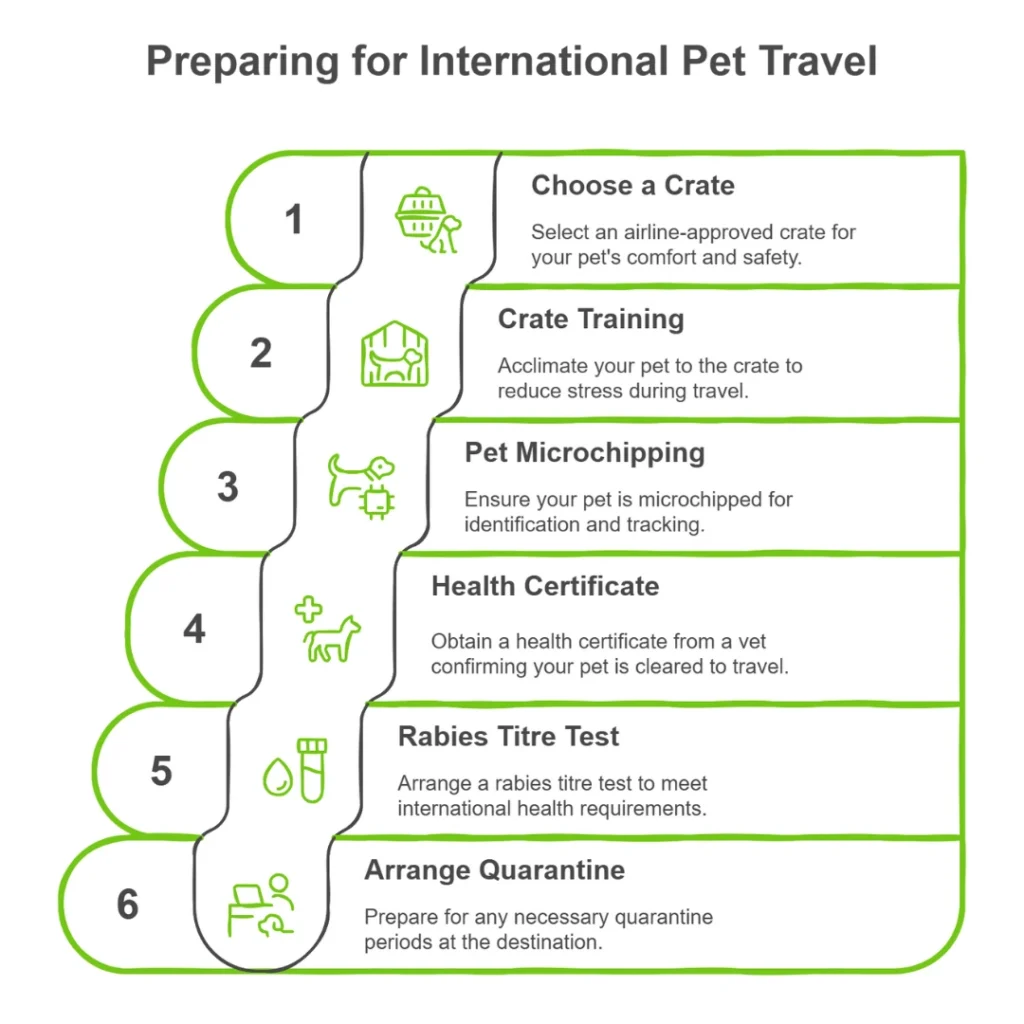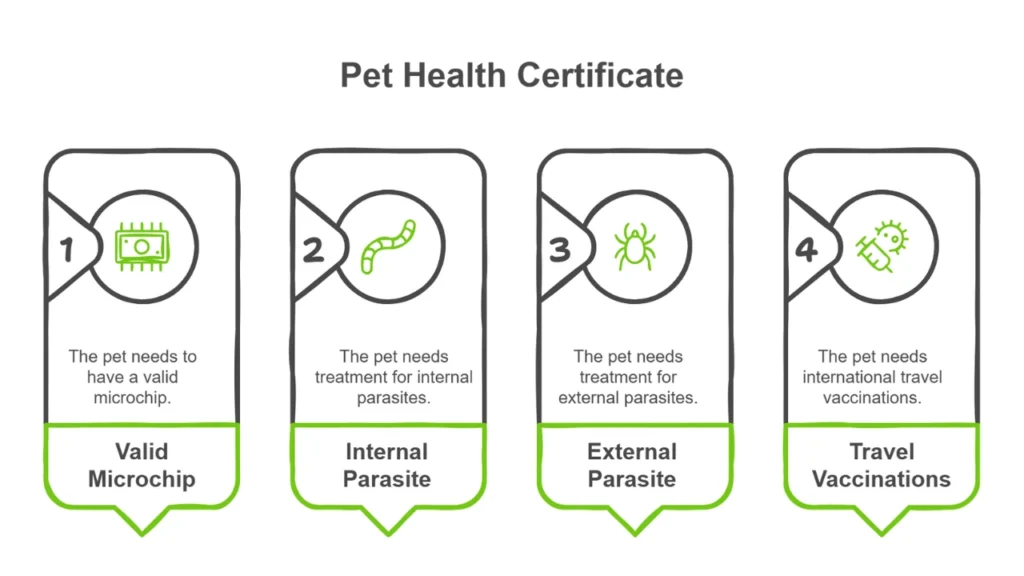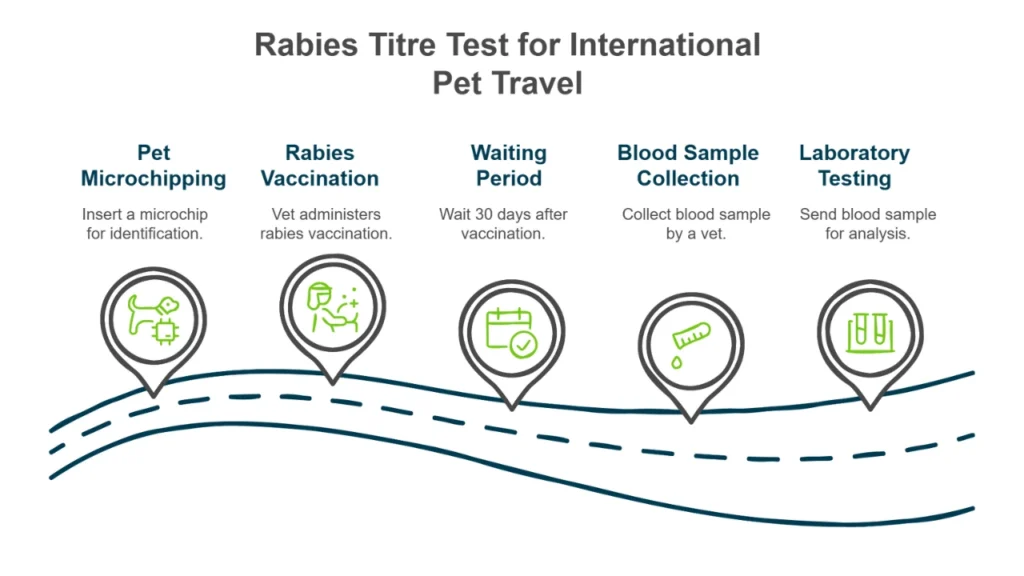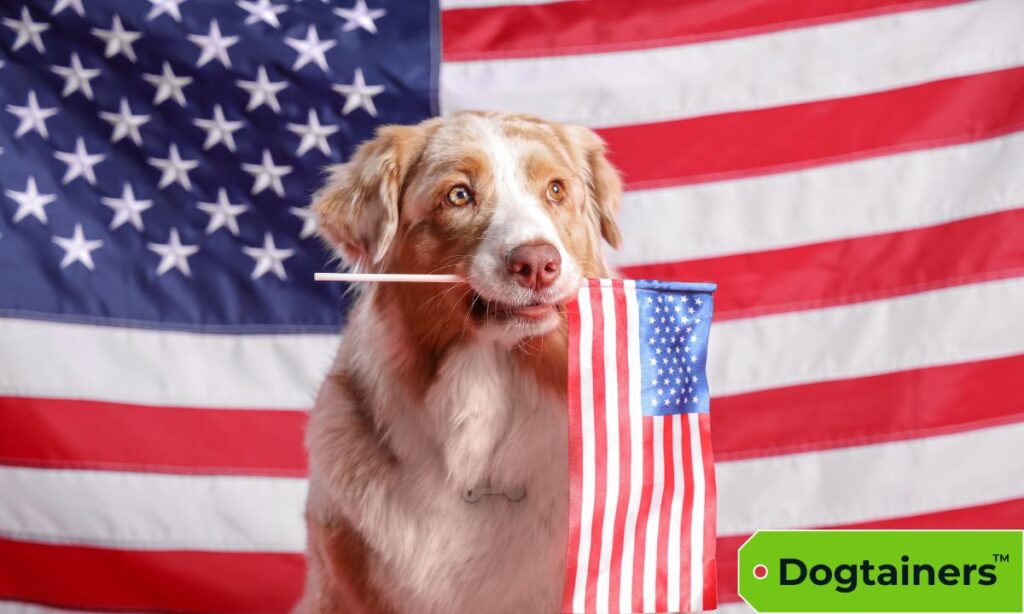Like many pet owners, the thought of bringing your dog or cat on a long-haul flight might fill you with anxiety. Will she be comfortable? Safe? What if she panics mid-flight?
The questions could keep you awake at night.
But it doesn’t have to be that way. With international pet travel, you don’t need to be stressed out.
Let me be clear:
- Flying with pets isn’t always easy.
- Airlines have strict rules.
- Documentation gets complicated.
But proper preparation and the help of experts set you and your pet up for a stress-free trip.
Discover how to prepare your dog or cat for a long international flight – from choosing the right carrier to navigating vaccination regulations.
Your pet’s journey starts long before takeoff – and so does your preparation.

Step 1: Choosing the Right Pet Crate
Flying pets internationally has some non-negotiable requirements. One of these is that your pet must travel in a compliant crate.
Airlines follow strict guidelines for pet crates. These are set by the International Air Transport Association (IATA).
Airline staff will stop your cat or dog from boarding the plane if you use a non-compliant crate. Choosing the right pet transport crate is crucial for a stress-free trip.
An airline-approved crate is:
- Made of sturdy, rigid plastic or wood (soft-sided carriers are not permitted for cargo travel)
- Large enough for your pet to stand, turn around, sit and lie down comfortably
- Safe and secure (with non-slip fasteners and a locking door)
- Well-ventilated on all four sides
Your pet’s safety and comfort also depend on the size of the crate.
If the crate is too small, your pet won’t have proper ventilation. Conversely, your pet will move around too much when the crate is too big, which may cause injury.
Pet Crate Size Guide*
| Crate | Maximum Pet Weight | Internal Dimensions | External Dimensions |
| PP-20 | Up to 7kg | 49cm x 32cm x 33cm | 53cm x 37cm x 37cm |
| PP-30 | Up to 11kg | 59cm x 40cm x 43cm | 62cm x 41cm x 45cm |
| PP-40 | Up to 14kg | 70cm x 41cm x 49cm | 73cm x 45cm x 53cm |
| PP-50 | Up to 22kg | 78cm x 51cm x 56cm | 82cm x 56cm x 60cm |
| PP-60 | Up to 32kg | 96cm x 57cm x 64cm | 93cm x 61cm x 68cm |
| PP-70 | Up to 42kg | 110cm x 60cm x 79cm | 115cm x 60cm x 80cm |
*These weights are recommendations only, final sizes will depend on the size/breed of your pet.
Want help choosing the perfect crate for your pet? Our experts ensure the crate complies with regulations so your pet boards the plane with minimal stress.
Step 2: Crate Training
Training your pet to be comfortable in the crate is vital for a stress-free trip on a long flight. I find this often gets overlooked by the general public but always recommend it (for flights of any duration).
Starting crate training as early as possible is best for your pet. This gives them time to acclimate to the crate and develop positive associations.
With a little time and patience, even the most anxious pets can feel safe and secure in their travel crate. They begin to feel relaxed there, setting them up for a stress-free journey.

Early Introduction: Start Crate Training Well Before Travel
Crate training shouldn’t be a last-minute task. Ideally, you’ll want to start the process at least 4–6 weeks before your departure date – earlier if your pet has never travelled in a crate before or is prone to anxiety.
Begin by simply introducing the crate into your home as a neutral or positive space. Avoid forcing your pet inside. Let them explore it at their own pace to build trust and confidence in their new “den.”
Pro tip: Place the crate in a commonly used area of your home so your pet becomes accustomed to seeing and smelling it regularly.
Make It Comfortable: Create a Safe, Familiar Space Inside
Comfort is key. Your pet’s crate should feel like a cosy retreat, not a punishment or prison.
Add a blanket, T-shirt, or toy that smells familiar to offer emotional reassurance during crate training. Familiar scents are incredibly soothing for pets in unfamiliar environments.
Encourage Exploration: Let Your Pet Enter Voluntarily
Once the crate is set up, leave the door open and allow your pet to explore it on their own. You can make it inviting by tossing in a few treats or feeding them meals just inside or near the entrance.
Use positive reinforcement – praise, pats, and rewards – every time they interact with the crate. The goal is to create a strong, positive association to promote safety instead of stress.
This voluntary exploration lays the foundation for calm and confident behaviour later when time in the crate becomes mandatory.
Practice Short Stays: Build Up Crate Time Gradually
Once your pet is comfortable entering and exiting the crate, begin closing the door for short periods while they’re inside. Stay nearby at first and offer reassurance through voice or visibility.
Gradually increase the duration of each session, from a few minutes to a few hours, so your pet becomes accustomed to longer confinement. Use treats, chew toys or puzzle feeders to keep them occupied.
Over time, your pet should learn that being in the crate is safe, even when you’re not within view.
Consistency is key: Practice daily for the best results, especially in the weeks leading up to your flight.
Simulate Travel Conditions: Prepare for Movement and Noise
Once your pet is comfortable with staying in the crate, it’s time to simulate the real thing. Start by carrying the crate gently around the house, then progress to short car rides to mimic the sensations of transport.
You can also place the crate in different rooms or environments to simulate changes in light, sound, and smell. This type of desensitisation can make a huge difference on travel day when the environment will be unfamiliar and potentially overwhelming.
Pro tip: Consider using a recording of plane sounds during crate time to help them adapt to flight noise.
Step 3: Microchipping Your Pet
Microchipping is crucial for the international pet travel process. For instance, your pet must be microchipped to leave for an overseas destination from Australia.
All destination countries require a microchip to be implanted before your pet receives its rabies vaccinations. Border authorities may consider the rabies vaccine invalid if administered before microchipping.
Pet microchipping is quick and painless for your pet. Typically, a vet implants the small electronic chip under the skin between the shoulder blades.

Are you bringing your pet to Australia? The microchip must:
- Meet the International Standards Organisation (ISO) specifications
- Operate at a 134.2 kHz frequency
- Be easily read by an ISO-compatible reader
- Have a corresponding number 10 or 15 digits long
- NOT have a corresponding number starting with 999
- NOT be an AVID microchip with a 9-digit corresponding number
The microchip links your pet to their documentation. It functions as your pet’s permanent identification throughout the journey.
The microchip serves as the definitive identifier. Authorities will scan the chip if questions arise about your pet’s identity or if paperwork gets lost.
In the unlikely event your pet escapes or gets lost, the pet microchip is also an invaluable insurance policy. Your contact information is linked to the chip, so they’re highly effective for reuniting lost pets with their owners.
Vets or animal shelter employees can scan the chip, pull up your contact details and get in touch. Discover more about pet microchipping in Australia.
Step 4: Health Certificate
Pet health certificates are an essential part of international pet travel. Your pet can’t travel overseas without one.
For international transport, your pet must have a health certificate to confirm its fitness for travel. The certificate also proves that your pet meets travel requirements for the destination country.
You must visit an approved vet to get your pet health certificate. The vet checks your pet’s overall health and will cover:
- Valid microchipping
- Internal and external parasite treatments
- Vaccinations for international travel

Internal Parasite Treatment
Not all countries have the same treatment rules and regulations. But I’ll outline the requirements for bringing your pet to Australia to give you an idea of the process.
Dogs and cats must be treated for internal parasites (nematodes and cestodes) twice before international travel.
- An approved vet should treat your pet within 45 days before the date of export.
- These treatments must be administered at least 14 days apart.
- The second treatment must be given within 5 days of travel.
Say you’re travelling on June 30. Your vet may follow this treatment schedule:
- First treatment on June 9
- Second treatment on June 27
These treatments are within 45 days of your travel date, at least 14 days apart and the second treatment is given within 5 days before you leave.
External Parasite Treatment
Dogs must get treated for ticks and fleas at least 30 days before travel. An approved vet must then treat your dog for ticks and fleas continuously until the date of travel.
Important: Not all brands are accepted forms of treatment. Speaking to a pet transport company before going ahead with treatment can save you time and money.
Has your dog visited mainland Africa? If so, you must get it treated for Babesia canis. An approved vet must administer this treatment within 28 days of travel to Australia.
For cats, treatment for fleas and ticks is similar. They must receive treatment at least 21 days before departure.
A vet should examine your cat for external parasites during subsequent visits, with ongoing treatment until export.
For your pet import permit, an approved vet must document and verify these treatments. You need proof of treatment before bringing pets into Australia.
International Pet Travel Vaccinations
When travelling with pets overseas, vaccination records are a non-negotiable part of the process. Depending on the departure and destination countries, dogs and cats travelling internationally may require a rabies vaccine. The timing requirements for the vaccine vary by country, though.
Required vaccinations to enter Australia are:
- The rabies vaccine is required for entry to Australia from most countries.
- The leptospirosis vaccine for dogs is mandatory if your dog hasn’t been tested.
- If entering Australia from an affected country, the canine influenza vaccine is required.
Recommended vaccinations for dogs (C5 vaccination) are:
- Distemper
- Hepatitis
- Parvovirus
- Para-influenza
- Bordetella bronchiseptica (kennel cough)
Recommended vaccinations for cats (F3 vaccination) are:
- Feline enteritis (panleukopenia or feline parvovirus)
- Feline calicivirus
- Feline herpesvirus (feline viral rhinotracheitis)
Like the rabies vaccine, the pet immunisation schedule depends on the destination country.
We have up-to-date information on all country schedules and help you navigate vaccine requirements for international pet travel.
Step 5: Rabies Titre Test
Many countries require your pet to undergo a rabies titre test before arrival. These include Australia, New Zealand and Japan. The exact schedule around administering the test differs between countries.

The rabies titre test measures the volume of rabies antibodies in your pet’s blood. It determines whether or not your pet has immunity to rabies.
Generally, your pet must undergo the rabies titre test around 30 days after the rabies vaccination. Waiting for this duration is enough time for your pet to develop an immune response.
You must use accredited laboratories for the rabies titre test, as per regulations from authorities of the destination country. Using accredited labs ensures adherence to stringent testing protocols and quality assurance standards. It also protects the accuracy and reliability of test results.
When bringing pets to Australia, authorities will reject tests that don’t follow Australian protocols. In this case, your pet may not be eligible for entry into the country.
The rabies titre test process is as follows:
- Microchipping: Get your pet microchipped before the rabies vaccination.
- Rabies Vaccination: Ensure an approved vet administers the rabies vaccination.
- Waiting Period: Generally, wait around 30 days after the vaccination before getting the rabies titre test – the timeframe may vary depending on the destination country.
- Blood Sample Collection: An approved vet collects a blood sample and sends it to an accredited lab for analysis after the waiting period.
- Laboratory Testing: The lab tests the blood sample and provides a report showing the rabies antibody level, which must meet the minimum requirements specified by the destination country.
If your pet fails the blood test, they need a booster vaccination and a second test 14-28 days later.
Regulations for international pet travel may vary between countries.
Dogtainers is here to guide you on rabies titre test regulations and help you with documentation.
Step 6: Arranging Quarantine (If Needed)
Pets travelling from certain countries must complete mandatory quarantine. This is an isolation period for animals before gaining entry to the destination region.
Quarantine helps protect local animal and human populations from harmful diseases. These include rabies, avian influenza and other zoonotic conditions.
The pet quarantine rules you need to follow vary depending on your country of departure and your destination.
For instance, pets travelling directly to Australia from New Zealand, Norfolk Island, and Cocos (Keeling) Island don’t have to quarantine. These countries are rabies-free, and pets flying from here are low risk.
Discover more in Pet Quarantine Australia (Your Questions Answered).
International Pet Travel with Dogtainers
Preparing your pet for a long flight doesn’t need to be overwhelming. With proper planning and some expert help, you can significantly reduce stress for both you and your pet.
From choosing the right carrier to visiting your vet for required treatments, each step builds toward a smoother travel experience.
We understand that international pet travel can be stressful for you. The good news is that you don’t have to go through the process alone.
Our experts have been helping pet owners like you with international pet travel for over 50 years. We’re Australia’s oldest and most reliable pet transport company with:
- Vast experience
- Industry credentials
- Tailored services
- Reliable global networks
- Strong airline partnerships
- Deep regulatory knowledge
We’re here to make your international pet travel experience safe, smooth and stress-free.
Get your quote today for international pet travel.





Share this article